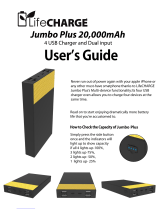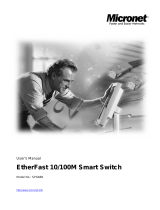Trendnet TEG240WS User manual
- Category
- Network switches
- Type
- User manual
This manual is also suitable for


FCC Warning
This equipment has been tested and found to comply with the
regulations for a Class A digital device, pursuant to Part 15 of the
FCC Rules. These limits are designed to provide reasonable protection
against harmful interference when the equipment is operated in a
commercial environment. This equipment generates, uses, and can
radiate radio frequency energy and, if not installed and used in
accordance with this user’s guide, may cause harmful interference to
radio communications. Operation of this equipment in a residential
area is likely to cause harmful interference, in which case the user will
be required to correct the interference at his or her own expense.
CE Mark Warning
This is a Class A product. In a domestic environment, this product
may cause radio interference, in which case the user may be required
to take adequate measures.
VCCI Warning
This is a product of VCCI Class A Compliance.

UL Warning
a) Elevated Operating Ambient Temperature- If installed in a closed
or multi-unit rack assembly, the operating ambient temperature of the
rack environment may be greater than room ambient. Therefore,
consideration should be given to installing the equipment in an
environment compatible with the manufacturer's maximum rated
ambient temperature (Tmra).
b) Reduced Air Flow- Installation of the equipment in a rack should
be such that the amount of air flow required for safe operation of the
equipment is not compromised.
c) Mechanical Loading- mounting of the equipment in the rack
should be such that a hazardous condition is not achieved due to
uneven mechanical loading.
d) Circuit Overloading- Consideration should be given to the
connection of the equipment to the supply circuit and the effect that
overloading of circuits might have on over current protection and
supply wiring. Appropriate consideration of equipment nameplate
ratings should be used when addressing this concern.
e) Reliable Earthing - Reliable earthing of rack-mounted equipment
should be maintained. Particular attention should be given to supply
connections other than direct connections to the branch circuit (e.g.,
use of power strips).
Ver. C1-1.00


i
TABLE OF CONTENT
About This Guide ................................................................................. 1
Purpose ............................................................................................ 1
Terms/Usage .................................................................................... 1
Introduction .......................................................................................... 3
Gigabit Ethernet Technology ........................................................... 3
Fast Ethernet Technology ................................................................ 4
Switching Technology ..................................................................... 5
VLAN (Virtual Local Area Network) .............................................. 6
Features ............................................................................................ 6
Unpacking and Installation .................................................................. 9
Unpacking ........................................................................................ 9
Installation ....................................................................................... 9
Rack Mounting .............................................................................. 10
Connecting Network Cable ............................................................ 11
AC Power ....................................................................................... 12
Identifying External Components ...................................................... 13
Front Panel ..................................................................................... 13
Rear Panel ...................................................................................... 14
Understanding LED Indicators .......................................................... 15
Power and System LEDs ............................................................... 15
1000BASE-T Port 1~24 Status LEDs ............................................ 16
Mini-GBIC Port 23 ~ 24 Status LEDs ........................................... 17
Configuration ..................................................................................... 19

Installing the Web Management Utility ......................................... 19
Discovery List ................................................................................ 20
Monitor List ................................................................................... 21
Device Setting ................................................................................ 23
Toolbar ........................................................................................... 25
Configuring the Switch .................................................................. 25
Login .............................................................................................. 26
Setup Setting .................................................................................. 27
Port Settings ............................................................................... 28
IEEE 802.1Q VLAN .................................................................. 29
Trunk Setting ............................................................................. 39
Mirror Setting............................................................................. 40
IEEE 802.1p Default Priority ..................................................... 41
Broadcast Storm Control Setting ............................................... 42
Jumbo Frame Setting ................................................................. 42
Advanced Setting ........................................................................... 43
SNMP Setting ............................................................................ 43
Spanning Tree Setting ................................................................ 45
802.1x Setting ............................................................................ 47
IGMP Snooping Setting ............................................................. 49
IGMP VLAN Setting ................................................................. 51
System Setting ............................................................................... 53
System Information .................................................................... 53
System Setting ........................................................................... 54
Trap Setting ................................................................................ 56
ii

iii
Password Setting ........................................................................ 57
Statistic ....................................................................................... 58
Factory Reset ............................................................................. 60
Backup Setting ........................................................................... 60
Firmware Upload ....................................................................... 61
System Reboot ........................................................................... 61
Logout ........................................................................................ 62
Technical Specifications ................................................................. 63


1
ABOUT THIS GUIDE
Congratulations on your purchase of the TEG-240WS 24-Port Gigabit
Web Smart Switch w/ 2 Shared Mini-GBIC Slots. This device
integrates 1000Mbps Gigabit Ethernet, 100Mbps Fast Ethernet and
10Mbps Ethernet network capabilities in a highly flexible package.
Purpose
This guide discusses how to install your TEG-240WS 24-Port Gigabit
Web Smart Switch w/ 2 Shared Mini-GBIC Slots.
Terms/Usage
In this guide, the term “Switch” (first letter upper case) refers to your
TEG-240WS 24-Port Gigabit Web Smart Switch w/ 2 Shared Mini-
GBIC Slots and “switch” (first letter lower case) refers to other
Ethernet switches.


3
INTRODUCTION
This chapter describes the features of the TEG-240WS 24-Port
Gigabit Web Smart Switch w/ 2 Shared Mini-GBIC Slots and some
background information about Ethernet/Fast Ethernet/Gigabit Ethernet
switching technology.
Gigabit Ethernet Technology
Gigabit Ethernet is an extension of IEEE 802.3 Ethernet utilizing the
same packet structure, format, and support for CSMA/CD protocol,
full duplex, flow control, and management objects, but with a tenfold
increase in theoretical throughput over 100-Mbps Fast Ethernet and a
hundredfold increase over 10-Mbps Ethernet. Since it is compatible
with all 10-Mbps and 100-Mbps Ethernet environments, Gigabit
Ethernet provides a straightforward upgrade without wasting a
company’s existing investment in hardware, software, and trained
personnel.
The increased speed and extra bandwidth offered by Gigabit Ethernet
is essential to coping with the network bottlenecks that frequently
develop as computers and their busses get faster and more users use
applications that generate more traffic. Upgrading key components,
such as your backbone and servers to Gigabit Ethernet can greatly
improve network response times as well as significantly speed up the
traffic between your subnets.
Gigabit Ethernet enables fast optical fiber connections to support
video conferencing, complex imaging, and similar data-intensive
applications. Likewise, since data transfers occur 10 times faster than
Fast Ethernet, servers outfitted with Gigabit Ethernet NIC’s are able to
perform 10 times the number of operations in the same amount of
time.

4
In addition, the phenomenal bandwidth delivered by Gigabit Ethernet
is the most cost-effective method to take advantage of today and
tomorrow’s rapidly improving switching and routing internetworking
technologies. And with expected advances in the coming years in
silicon technology and digital signal processing that will enable
Gigabit Ethernet to eventually operate over unshielded twisted-pair
(UTP) cabling, outfitting your network with a powerful 1000-Mbps-
capable backbone/server connection creates a flexible foundation for
the next generation of network technology products.
Fast Ethernet Technology
The growing importance of LANs and the increasing complexity of
desktop computing applications are fueling the need for high
performance networks. A number of high-speed LAN technologies
have been proposed to provide greater bandwidth and improve
client/server response times. Among them, 100BASE-T (Fast
Ethernet) provides a non-disruptive, smooth evolution from the
current 10BASE-T technology. The non-disruptive and smooth
evolution nature, and the dominating potential market base, virtually
guarantees cost-effective and high performance Fast Ethernet
solutions.
100Mbps Fast Ethernet is a standard specified by the IEEE 802.3
LAN committee. It is an extension of the 10Mbps Ethernet standard
with the ability to transmit and receive data at 100Mbps, while
maintaining the CSMA/CD Ethernet protocol. Since the 100Mbps
Fast Ethernet is compatible with all other 10Mbps Ethernet
environments, it provides a straightforward upgrade and takes
advantage of the existing investment in hardware, software, and
personnel training.

5
Switching Technology
Another approach to pushing beyond the limits of Ethernet technology
is the development of switching technology. A switch bridges
Ethernet packets at the MAC address level of the Ethernet protocol
transmitting among connected Ethernet or Fast Ethernet LAN
segments.
Switching is a cost-effective way of increasing the total network
capacity available to users on a local area network. A switch
increases capacity and decreases network loading by dividing a local
area network into different segments, which don’t compete with each
other for network transmission capacity.
The switch acts as a high-speed selective bridge between the
individual segments. The switch, without interfering with any other
segments, automatically forwards traffic that needs to go from one
segment to another. By doing this the total network capacity is
multiplied, while still maintaining the same network cabling and
adapter cards.
Switching LAN technology is a marked improvement over the
previous generation of network bridges, which were characterized by
higher latencies. Routers have also been used to segment local area
networks, but the cost of a router, the setup and maintenance required
make routers relatively impractical. Today switches are an ideal
solution to most kinds of local area network congestion problems.

6
VLAN (Virtual Local Area Network)
A VLAN is a group of end-stations that are not constrained by their
physical location and can communicate as if a common broadcast
domain, a LAN. The primary utility of using VLAN is to reduce
latency and need for routers, using faster switching instead. Other
VLAN utility includes:
Security, Security is increased with the reduction of opportunity in
eavesdropping on a broadcast network because data will be switched
to only those confidential users within the VLAN.
Cost Reduction, VLANs can be used to create multiple broadcast
domains, thus eliminating the need of expensive routers.
Features
24 x 1000BASE-T Auto-negotiation Gigabit Ethernet ports
2 x Combo mini-GBIC (Auto-Sense) for optional mini-GBIC
transceiver to extend distance, share with 2 1000BASE-T ports
All 1000BASE-T ports support auto MDI/MDIX, so there is no
need to use cross-over cables or an up-link port
Half duplex transfer mode for connection speed 10Mbps and
100Mbps
Full duplex transfer mode for connection speed of 10Mbps,
100Mbps and 1000Mbps
Store-and-Forward switching scheme capability to support rate
adaptation and ensure data integrity
Up to 8K unicast addresses entities per device, self-learning, and
table aging
512 KBytes packet buffer

7
Supports IEEE 802.3x flow control for full-duplex mode ports
Supports IEEE 802.1Q VLAN
Supports IEEE 802.1p Priority Queues
Supports Static Port Trunk
Supports IGMP Snooping
Supports SNMP for RFC1213 MIB II and Private MIB
Supports IEEE 802.1D Spanning Tree
Supports 802.1x port based access control
Supports Jumbo Frame
Supports Broadcast Storm Control
Supports Port Mirroring
Supports Port Setting for Speed, Flow control
Easy configuration via WEB Browser
Easy setting via Web Management Utility
Standard 19” Rack-mount size


9
UNPACKING AND INSTALLATION
This chapter provides unpacking and installation information for the
Switch.
Unpacking
Open the shipping cartons of the Switch and carefully unpacks its
contents. The carton should contain the following items:
TEG-240WS 24-Port Gigabit Web Smart Switch w/ 2 Shared
Mini-GBIC Slots
Multi-Language Quick Installation Guide
CD-COM (Utility & User’s Guide)
Power Cord
Rack Mount Kit (Rubber Feet, Screws and Mounting Brackets)
If any item is found missing or damaged, please contact your local
reseller for replacement
Installation
The site where you install the hub stack may greatly affect its
performance. When installing, consider the following pointers:
Install the Switch in a fairly cool and dry place. See Technical
Specifications for the acceptable temperature and humidity operating
ranges.
Install the Switch in a site free from strong electromagnetic field
generators (such as motors), vibration, dust, and direct exposure to
sunlight.
Leave at least 10cm of space at the front and rear of the hub for
ventilation.

10
Install the Switch on a sturdy, level surface that can support its weight,
or in an EIA standard-size equipment rack. For information on rack
installation, see the next section, Rack Mounting.
When installing the Switch on a level surface, attach the rubber feet to
the bottom of each device. The rubber feet cushion the hub and
protect the hub case from scratching.
Figure 1. Attach the adhesive rubber pads to the bottom
Rack Mounting
The switch can be mounted in an EIA standard-size, 19-inch rack,
which can be placed in a wiring closet with other equipment. Attach
the mounting brackets at the switch’s front panel (one on each side),
and secure them with the provided screws.
Figure 2. Combine the Switch with the provided screws

11
Then, use screws provided with the equipment rack to mount each
switch in the rack.
Figure 3. Mount the Switch in the rack
Connecting Network Cable
The Switch supports 1000Mbps Gigabit Ethernet that runs in Auto-
negotiation mode and 10Mbps Ethernet or 100Mbps Fast Ethernet that
runs both in half and full duplex mode and 1000Mbps Gigabit
Ethernet runs in full duplex mode using four pairs of Category 5
cable.
These 1000BASE-T ports are Auto-MDI type port. The Switch can
auto transform to MDI-II or MDI-X type, so you can just make an
easy connection that without worrying if you are using a standard or
crossover twisted-pair cable.
There are additional 2 ports combo mini-GBIC slot for optional mini-
GBIC module.

12
AC Power
The Switch used the AC power supply 100-240V AC, 50-60 Hz. The
power switch is located at the rear of the unit adjacent to the AC
power connector and the system fan. The switch’s power supply will
adjust to the local power source automatically and may be turned on
without having any or all LAN segment cables connected.
Page is loading ...
Page is loading ...
Page is loading ...
Page is loading ...
Page is loading ...
Page is loading ...
Page is loading ...
Page is loading ...
Page is loading ...
Page is loading ...
Page is loading ...
Page is loading ...
Page is loading ...
Page is loading ...
Page is loading ...
Page is loading ...
Page is loading ...
Page is loading ...
Page is loading ...
Page is loading ...
Page is loading ...
Page is loading ...
Page is loading ...
Page is loading ...
Page is loading ...
Page is loading ...
Page is loading ...
Page is loading ...
Page is loading ...
Page is loading ...
Page is loading ...
Page is loading ...
Page is loading ...
Page is loading ...
Page is loading ...
Page is loading ...
Page is loading ...
Page is loading ...
Page is loading ...
Page is loading ...
Page is loading ...
Page is loading ...
Page is loading ...
Page is loading ...
Page is loading ...
Page is loading ...
Page is loading ...
Page is loading ...
Page is loading ...
Page is loading ...
Page is loading ...
Page is loading ...
Page is loading ...
Page is loading ...
Page is loading ...
-
 1
1
-
 2
2
-
 3
3
-
 4
4
-
 5
5
-
 6
6
-
 7
7
-
 8
8
-
 9
9
-
 10
10
-
 11
11
-
 12
12
-
 13
13
-
 14
14
-
 15
15
-
 16
16
-
 17
17
-
 18
18
-
 19
19
-
 20
20
-
 21
21
-
 22
22
-
 23
23
-
 24
24
-
 25
25
-
 26
26
-
 27
27
-
 28
28
-
 29
29
-
 30
30
-
 31
31
-
 32
32
-
 33
33
-
 34
34
-
 35
35
-
 36
36
-
 37
37
-
 38
38
-
 39
39
-
 40
40
-
 41
41
-
 42
42
-
 43
43
-
 44
44
-
 45
45
-
 46
46
-
 47
47
-
 48
48
-
 49
49
-
 50
50
-
 51
51
-
 52
52
-
 53
53
-
 54
54
-
 55
55
-
 56
56
-
 57
57
-
 58
58
-
 59
59
-
 60
60
-
 61
61
-
 62
62
-
 63
63
-
 64
64
-
 65
65
-
 66
66
-
 67
67
-
 68
68
-
 69
69
-
 70
70
-
 71
71
-
 72
72
-
 73
73
-
 74
74
-
 75
75
Trendnet TEG240WS User manual
- Category
- Network switches
- Type
- User manual
- This manual is also suitable for
Ask a question and I''ll find the answer in the document
Finding information in a document is now easier with AI
Related papers
-
Trendnet TEG-160WS User guide
-
Trendnet TEG-240WS User guide
-
Allnet ALL4704W User guide
-
Trendnet TEG-224WS Owner's manual
-
Trendnet TEG-2248WS User guide
-
Trendnet TE100-S24WS Owner's manual
-
Trendnet TEG-S224TX Owner's manual
-
Trendnet TEG-424WS User guide
-
Trendnet RB-TEG-160WS User guide
-
Trendnet TEG-160WS User guide
Other documents
-
 lifeCharge JUMBO PLUS User manual
lifeCharge JUMBO PLUS User manual
-
Encore electronic ENMGS-16+2 User manual
-
Allnet ALL4703W User guide
-
 MicroNet Technology SP648B User manual
MicroNet Technology SP648B User manual
-
 Planex SW-2248F User manual
Planex SW-2248F User manual
-
MicroNet SP6052WS User manual
-
Comet Labs GSM2400R Owner's manual
-
Allnet ALL4706W User manual
-
Allnet ALL4701W User guide
-
D-Link DES-1250G User manual













































































